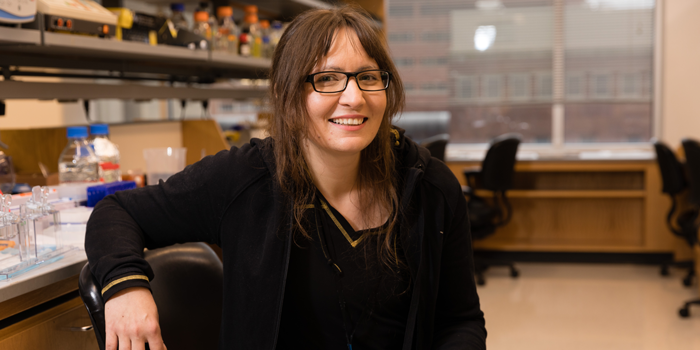Cell-like microfactories open new doors to manufacturing biological molecules and understanding the origins of life.

Kate Adamala, an assistant professor in the college's Department of Genetics, Cell Biology and Development, pictured in her lab. Photo: Jonathan Pavlica
As Henry Ford demonstrated more than a century ago, the most efficient way to build something with multiple components is to manufacture the separate parts and then put them together them in sequence to make the final product. In Ford’s case the “something” was the size of a car — in fact, it was a car — and the strategy was to move it from station to station along an assembly line, adding parts along the way. But what if the desired product is a minute but complex biological molecule, such as a drug or an industrial chemical?
Researchers, led by College of Biological Sciences researcher Kate Adamala, have come up with an exciting answer. Adamala and colleagues from the Massachusetts Institute of Technology have devised a way to encase molecule-making machinery in tiny fat bubbles known as liposomes and get them to connect and communicate with each other in a way that allows them to serve as individual stations in a complex-molecule assembly line. The compartmentalization makes it easier to ensure molecular components are in the right place at the right time in the presence of the right tools, and avoids challenges of having things interact in an inappropriate order or in a way that produces undesired products.
“A lot of the time, what is good for one step in the molecular construction process is not good for another,” Adamala says. “For example, a drug might need to be processed in a specific order by a series of different enzymes, but the enzymes downstream could process not only the compound we want it to, but also an earlier one. By separating the reactions, we can control each one separately and make sure they proceed in the right order.”
To develop the molecular assembly line, the researchers first built liposomes that enclosed genetic machinery needed to make luciferase, the compound that makes fireflies glow. They found that physically separating the luciferase-building steps allowed for independent control of each step while still yielding a fully functional final product. Next, the team members showed that the liposomes housing separate steps of the assembly line can indeed be near each other without adversely affecting each other. Finally, they successfully assembled a luciferase-producing assembly line — establishing sequential communication among two different liposomes so that one produced a molecule that then signaled a second one to produce luciferase. In addition, they showed it was possible to instruct two liposomes to fuse, making it possible to mix their contents on command.
Adamala is now working to apply the approach to building more and more complex assembly lines for mass-producing molecules. Eventually she hopes to team with other University of Minnesota researchers to develop systems to produce specific drugs and other biological molecules for medical or industrial use.
She’s also using the liposomes as a model for exploring one of the fundamental mysteries of our universe: How life arose. “When life started, it had to start from a much simpler point than modern cells,” Adamala says. “We can use these liposomes to model what the earliest life could have looked like and explore how it became increasingly complex.”
Adamala began the work as a postdoctoral fellow at MIT; she’s enthusiastic about continuing it here. “The University of Minnesota is a strong community for supporting this kind of research,” she says. “This is a great place for advancing our understanding and use of this important tool.” — Mary Hoff
Read the paper, Engineering genetic circuit interactions within and between synthetic minimal cells, in Nature Chemistry.